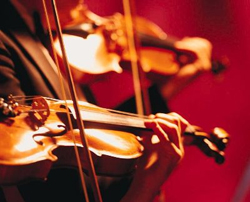
Rock with strings in the background, I’m going to reach for a set of ribbons.
I want a lot of space, but not necessarily a lot of room, if that makes sense.
And that ribbon tone seems connotative of that rock sound.
Soul music, I’m going for some condensers, set cardioid, because I want those buzzing harmonics. Classical, I want some omni condensers, pristine capture with the sound of the hall equally involved.
Remember, these are just starting points – you may find that you’re getting results that don’t match up with expectations and that means figure out what you want and make adjustments.
Concentric Mono
Phase is no joke when it comes to strings. With all those harmonics hoping around, it’s almost impossible to get a spaced pair to have perfect phase.
Did I say almost? Scratch that.
Perfect phase on a string ensemble of any size is impossible. A spaced pair, even from an imaginary center point, will always leave some strings in phase and some strings out – and the harmonics will alternate between in phase and out of phase.
But don’t fret (no pun intended) – there’s an advantage to an out of phase capture: Wider stereo image.
So how does one get a wide stereo image and keep a solid mono sound? Two ways. One is to set up an XY or ORTF configuration. The sound all reaches the mics at essentially the same time, so you stay safe.
Another technique is to use a third “glue” mic. Your stereo pair might never be in phase with the strings, but they can be in phase with a third, omni directional mic.
If you place that mic somewhere that seems to gather the whole ensemble sound evenly it will help the stereo pair feel concentric. And, when you fold to mono you won’t lose the sense of evenness of the entire ensemble.
Usually this glue mic sounds like crud in solo. It’s meant to be tucked underneath the stereo pair, which is doing the majority of the work.
The more glue mic you can get (or conversely less of the stereo pair) while still keeping an acceptable sense of width and tone, the better your mono fold will be. There’s usually a sweet spot that makes everything happy.
Prepared For Anything
Keep a couple of auxiliary mics ready to go. Occasionally you will get a great capture, but the mix is going to require just a little more of one element. This is especially true in smaller ensembles, quintets, or quartet work.
Sometimes a mic placed relatively close to the body of the instrument and aimed at the f-hole tucked into your main capture is just the ticket.
The f-hole is where the fundamental tones of the instrument most clearly resonates – it’s not always the best place to capture a solo string instrument because you miss out on the bow sound, finger noise, and bridge harmonics – but for ensemble work you really only want the fundamental tones for an auxiliary boost.
Experiment
Don’t be afraid to experiment, even when the clock is ticking. It’s worth listening to your instincts. Old Philly-Soul and Motown strings were often cut with rows of stereo pair condensers.
The power of the instruments and the clarity of harmonics were more important to the sound than scopic depth. This quintessential stylistic (again, no pun intended) sound was the result of going for something less conventional and more by instinct.
Matthew Weiss is the head engineer for Studio E, located in Philadelphia. Recent credits include Ronnie Spector, Uri Caine, Royce Da 5’9” and Philadelphia Slick.
Be sure to visit the Pro Audio Files for more great recording content. To comment or ask questions about this article go here.
